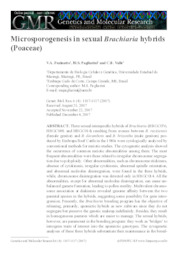Microsporogenesis in sexual Brachiaria hybrids (Poaceae) forrageiras.
Microsporogenesis in sexual Brachiaria hybrids (Poaceae) forrageiras.
Autoria: FUZINATTO, V. A.; PAGLIARINI, M. S.; VALLE, C. B. do
Resumo: ABSTRACT - Three sexual interspecific hybrids of Brachiaria (HBGC076, HBGC009, and HBGC014) resulting from crosses between B. ruziziensis (female genitor) and B. decumbens and B. brizantha (male genitors) produced by Embrapa Beef Cattle in the 1980s were cytologically analyzed by conventional methods for meiotic studies. The cytogenetic analysis showed the occurrence of common meiotic abnormalities among them. The most frequent abnormalities were those related to irregular chromosome segregation due to polyploidy. Other abnormalities, such as chromosome stickiness, absence of cytokinesis, irregular cytokinesis, abnormal spindle orientation, and abnormal nucleolus disintegration, were found in the three hybrids, while, chromosome disintegration was detected only in HBGC014. All the abnormalities, except for abnormal nucleolus disintegration, can cause unbalanced gamete formation, leading to pollen sterility. Multivalent chromosome association at diakinesis revealed genome affinity between the two parental species in the hybrids, suggesting some possibility for gene introgression. Presently, the Brachiaria breeding program has the objective of releasing, primarily, apomictic hybrids as new cultivars since they do not segregate but preserve the genetic makeup indefinitely. Besides, they result in homogeneous pastures which are easier to manage. The sexual hybrids, however, are paramount in the breeding program: they work as 'bridges' to introgress traits of interest into the apomictic genotypes. The cytogenetic analyses of these three hybrids substantiate their maintenance in the breeding program due to low frequency of meiotic abnormalities, complemented by interesting agronomic traits. They may be used in crosses to generate new cultivars in the future.
Ano de publicação: 2007
Tipo de publicação: Parte de livro (capítulos de livros, trabalhos e resumos publicados em anais ou em coletâneas)
Unidade: Embrapa Gado de Corte
Observações
1 - Por padrão são exibidas publicações dos últimos 20 anos. Para encontrar publicações mais antigas, configure o filtro ano de publicação, colocando o ano a partir do qual você deseja encontrar publicações. O filtro está na coluna da esquerda na busca acima.
2 - Para ler algumas publicações da Embrapa (apenas as que estão em formato ePub), é necessário ter, no celular ou computador, um desses softwares gratuitos. Sistemas Android: Google Play Livros; IOS: iBooks; Windows e Linux: software Calibre.
Acesse outras publicações
Acesse a Base de Dados da Pesquisa Agropecuária (BDPA) para consultar o acervo completo das bibliotecas da Embrapa.

